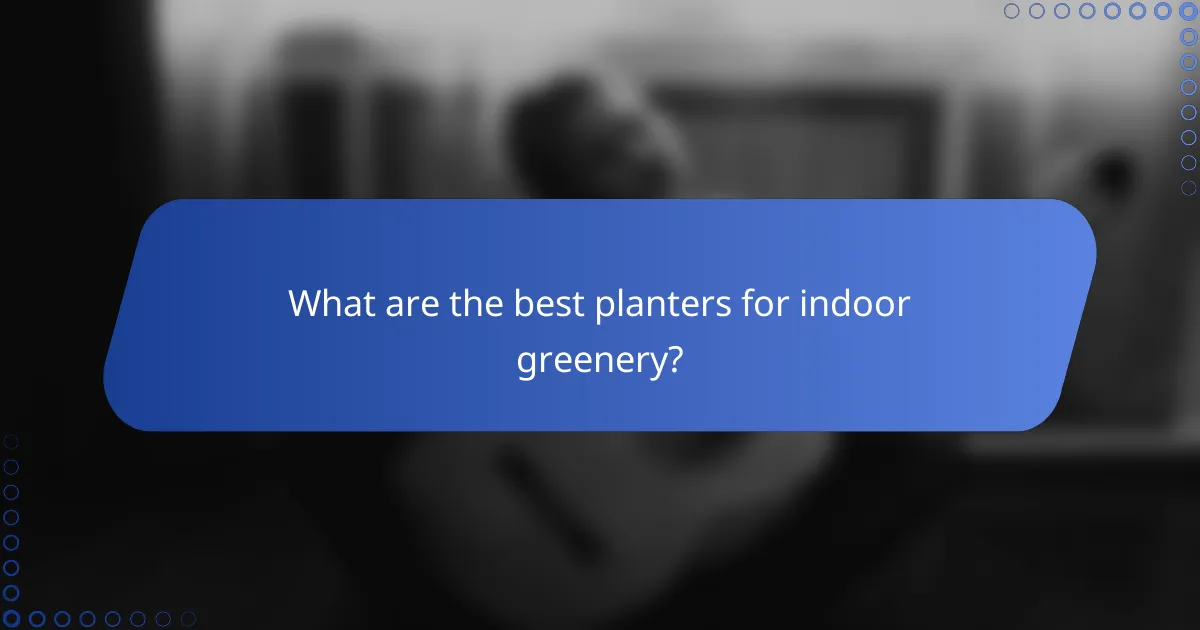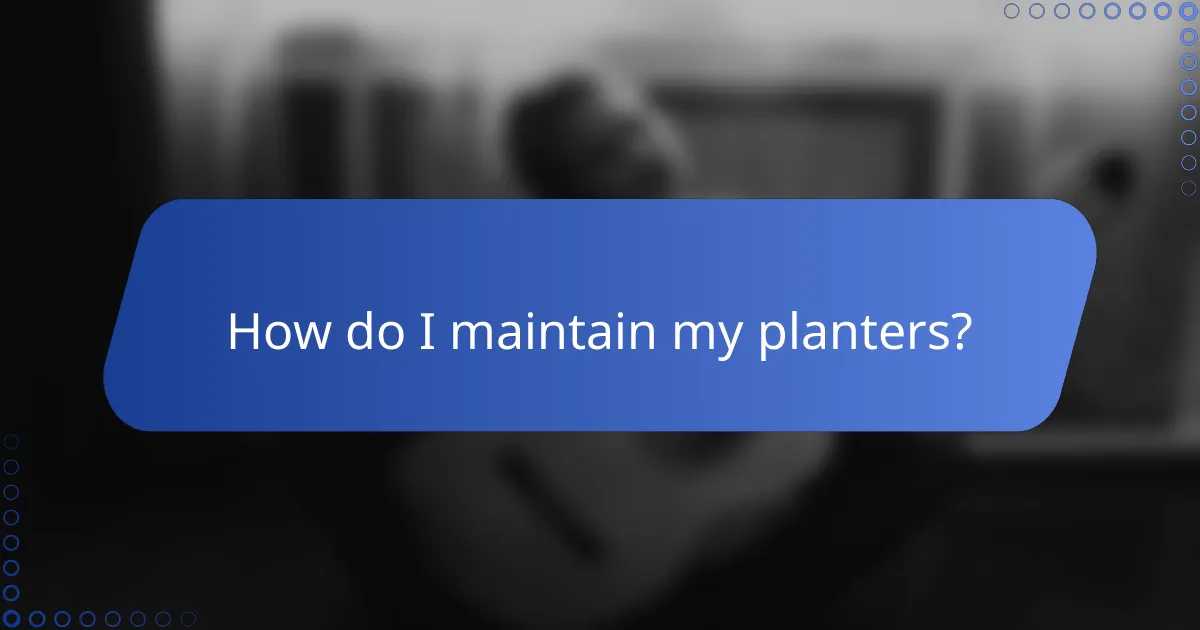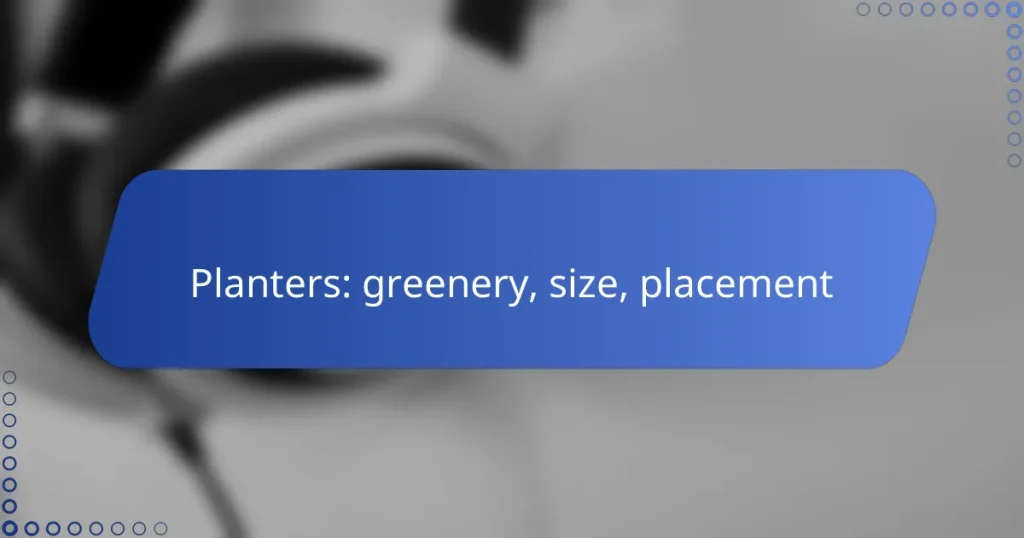Choosing the right planters is essential for enhancing both the health of your indoor greenery and the overall aesthetics of your space. Considerations such as water retention, size, and placement play a crucial role in ensuring your plants thrive. Proper planter size allows for adequate growth and drainage, while strategic placement maximizes exposure to light and airflow.

What are the best planters for indoor greenery?
The best planters for indoor greenery enhance plant health and aesthetics. Consider factors like water retention, style, and space when selecting planters for your home.
Self-watering planters
Self-watering planters are designed with a reservoir that allows plants to absorb moisture as needed. This feature helps prevent overwatering and ensures consistent hydration, making them ideal for busy individuals or those new to plant care.
When choosing self-watering planters, look for models with a clear indicator for water levels. They come in various sizes, suitable for small herbs or larger houseplants, and can be made from materials like plastic or ceramic.
Hanging planters
Hanging planters are perfect for maximizing vertical space and adding greenery to walls or ceilings. They can create a stunning visual effect and are often used for trailing plants like pothos or ivy.
When selecting hanging planters, ensure they are lightweight yet sturdy enough to hold the plant’s weight. Consider using macramé hangers or wall-mounted brackets to secure them safely.
Decorative ceramic pots
Decorative ceramic pots add a touch of style to your indoor greenery. They come in various colors and designs, allowing you to match them with your home decor.
While ceramic pots are visually appealing, they can be heavy and may require drainage holes to prevent waterlogging. Choose pots with a glaze finish for easier cleaning and maintenance.
Plastic nursery pots
Plastic nursery pots are lightweight and affordable, making them a popular choice for starting plants. They often come in standard sizes and are ideal for seedlings or temporary housing before transplanting.
These pots typically have drainage holes, which help prevent root rot. However, they may not be as aesthetically pleasing, so consider placing them inside decorative covers for a more polished look.
Wooden planter boxes
Wooden planter boxes offer a rustic charm and can be customized to fit various spaces. They work well for larger plants or multiple smaller plants grouped together.
When using wooden planters, ensure they are treated to resist moisture and pests. Consider lining the inside with plastic to prolong the life of the wood and maintain soil moisture effectively.

How to choose the right planter size?
Choosing the right planter size is crucial for the health of your plants. A suitable planter provides adequate space for growth while ensuring proper drainage and aeration.
Consider plant size and growth
When selecting a planter, consider the mature size of your plant. For small plants, a pot with a diameter of around 15-20 cm is often sufficient, while larger plants may require pots that are 30 cm or more. Always choose a planter that allows for some extra space to accommodate future growth.
Keep in mind that different species have varying growth rates and sizes. For instance, a fast-growing plant like a fiddle leaf fig may need a larger planter sooner than a slow-growing succulent.
Account for root space
Roots need room to spread out for optimal nutrient absorption and stability. A general rule is to select a planter that is at least twice the size of the root ball. For example, if your plant’s root ball is 10 cm wide, opt for a planter that is at least 20 cm wide.
Ensure the planter has drainage holes to prevent waterlogging, which can lead to root rot. If you’re unsure, consider using a planter with a drainage tray to catch excess water.
Match planter size to room scale
The size of your planter should complement the space it occupies. In smaller rooms, choose compact planters that don’t overwhelm the area, while larger spaces can accommodate bigger planters. For instance, a tall plant in a small pot may look unbalanced.
As a guideline, a planter should ideally occupy about one-third of the height of the plant. This proportion helps create a visually appealing arrangement and ensures the plant is supported properly.

Where should I place my planters?
Planters should be strategically placed to maximize plant health and growth. Consider factors such as light, humidity, and airflow to ensure your greenery thrives.
Near natural light sources
Positioning planters near natural light sources is crucial for most plants, as they require adequate sunlight for photosynthesis. South-facing windows typically provide the most consistent light throughout the day, making them ideal spots for planters.
For plants that thrive in direct sunlight, consider placing them within 1-2 meters of the window. However, for those that prefer indirect light, a distance of 2-3 meters may be more suitable. Regularly rotate your planters to ensure even growth.
In humidity-rich areas
Humidity is essential for many houseplants, especially tropical varieties. Placing planters in naturally humid areas, such as kitchens or bathrooms, can help maintain the moisture levels they need to flourish.
If natural humidity is low, consider using a humidity tray or a small humidifier nearby. Grouping plants together can also create a microclimate, increasing humidity around them. Aim for humidity levels between 40-60% for optimal growth.
Away from drafts
Drafts can stress plants and lead to issues such as wilting or leaf drop. It’s important to keep planters away from doors, windows, and air conditioning vents where cold or hot air can disrupt their environment.
When selecting a location, test the airflow by observing how it feels in different seasons. Ideally, planters should be placed in stable temperature zones, avoiding areas where temperatures fluctuate significantly. This will help maintain a consistent environment for your plants.

What are the benefits of using planters?
Using planters offers numerous advantages, including improved air quality, enhanced aesthetic appeal, and effective space optimization. These benefits make planters an excellent choice for both indoor and outdoor environments.
Improved air quality
Planters can significantly enhance air quality by supporting the growth of plants that naturally filter pollutants. Plants absorb carbon dioxide and release oxygen, contributing to a healthier atmosphere.
Some species, like peace lilies and snake plants, are particularly effective at removing toxins from the air. Incorporating these plants into your space can lead to a noticeable improvement in indoor air quality.
Enhanced aesthetic appeal
Planters add visual interest and vibrancy to any space, transforming dull areas into lively environments. They come in various styles, sizes, and materials, allowing for customization to match your decor.
Whether you choose sleek modern designs or rustic wooden options, planters can complement both indoor and outdoor settings. Strategically placing planters can create focal points and enhance the overall ambiance of your space.
Space optimization
Planters are an effective way to maximize limited space, especially in urban environments. Vertical planters or wall-mounted options can utilize vertical space, making it possible to grow plants even in small areas.
Additionally, using planters allows for organized plant arrangements, making maintenance easier. Consider grouping planters to create designated green zones, which can enhance both functionality and aesthetics in compact spaces.

How do I maintain my planters?
Maintaining your planters involves regular care routines to ensure healthy plant growth. Key aspects include a consistent watering schedule, seasonal soil replacement, and effective pest control measures.
Regular watering schedule
A regular watering schedule is crucial for the health of your plants. Most indoor and outdoor planters require watering at least once a week, but this can vary based on plant type, climate, and pot size.
To determine when to water, check the top inch of soil; if it’s dry, it’s time to water. Be cautious not to overwater, as this can lead to root rot. Consider using self-watering planters if you travel frequently or have a busy schedule.
Soil replacement every season
Replacing the soil in your planters every season helps replenish nutrients and improve drainage. Over time, soil can become compacted and depleted of essential minerals, which can hinder plant growth.
When replacing soil, choose a high-quality potting mix suitable for your specific plants. Remove old soil gently and ensure that the roots are not damaged. This practice is particularly important for flowering plants and vegetables, which require nutrient-rich soil to thrive.
Pest control measures
Implementing pest control measures is essential to protect your planters from infestations. Regularly inspect your plants for signs of pests such as aphids, spider mites, or whiteflies.
Use natural remedies like neem oil or insecticidal soap to treat minor infestations. For severe cases, consider introducing beneficial insects like ladybugs or using traps. Always follow product instructions carefully to ensure safety and effectiveness.


